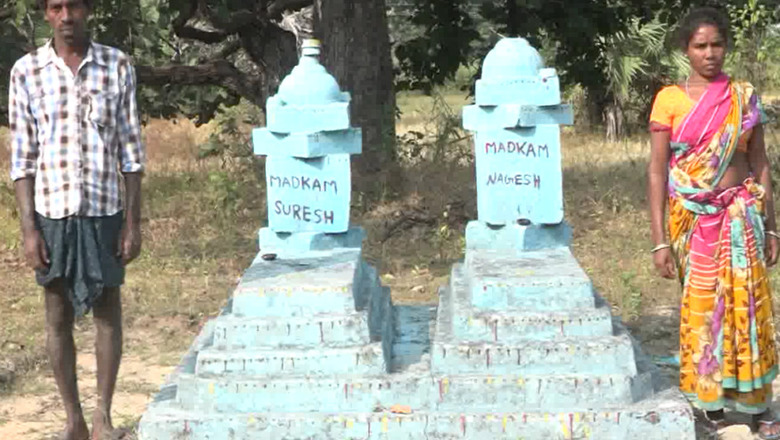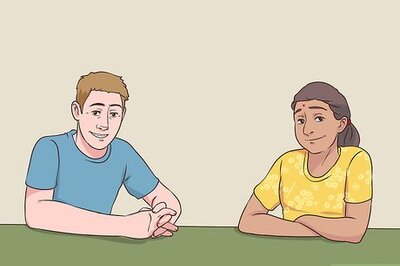
views
Sammikaram somehow manages to maintain composure while recalling that day. Neighbour Pullaya Sarke, however, breaks down. “Ten people of my family were killed. We had gathered for some festivities...Security personnel came and killed ten of them,” says Sammikaram, a resident of Sarkeguda village in Chhattisgarh's Bijapur district.
The case of an alleged fake encounter by security forces in 2012 in the south Bastar region is heating up. After questions were raised over the death of 17 people in the incident, the-then Bharatiya Janata Party (BJP) government had constituted a one-member judicial inquiry commission of Justice (Retd) VK Agrawal.
The authority submitted a report on October 17, stating there was no evidence that those killed were Maoists, and it detected “manipulation in probe” after the killings. The present Congress government of the state, it seems, is contemplating action on the basis of this, for the alleged unprovoked killing of villagers.
Shanta Madkam (52) of Sarkeguda wants the culprits to be hanged. She lost her two sons, Nagesh (16) and Suresh (12), that day. Shanta says the firing took place when the whole village had assembled to celebrate the traditional agricultural festival of Beej Pandum. Security personnel encircled them and fired from all sides while their houses were set on fire, she alleges.
These are the 17 people who died and some findings about them:
1. Saraswati (12) - The youngest among those killed, she had no Naxal record. Her father Kaka Ram is a poor farmer and produces mainly rice and tamarind.
2. Kaka Samaiyya (35-40) - Samaiyya had no Naxal record. His four children and wife survive him.
3. Kaka Nagesh aka Rahul (15) - A class 10 student, Nagesh was studying in a government boarding school in Basaguda.
4. Madakam Ramvilas (15) - He had no Naxal record. He was a schoolmate of Rahul. His family said he always stood first in his class and was good at English.
5. Madakam Dileep (22) - He had studied till class 8. Police had alleged that Dilip had attacked a police patrol on October 24, 2009, near the banks of Talperu river.
6. Irpa Munna (23) - There's no Naxal record against him. His father alleged that to save himself he had climbed a tree. But after he came down hours later, security personnel opened fire and killed him.
7. Madakam Suresh (35) - During the days of the anti-insurgency militia Salwa Judum, he was arrested along with his mother in 2007, and was sent to jail with thousands of other tribals. During the Dantewada prison break in 2007, Suresh managed to escape with another 298 prisoners. Later, Suresh returned to his village, got married and had two children. Apart from the jailbreak case, he had another four cases against him. In all these cases, the charges against him were the same- attacking a police party with the intention of killing them.
8. Madakam Nagesh (32) - He was the brother of Madakam Suresh and would play the drums during festivals in his village. A case was filed against him in 2006, alleging that he tried to attack a police party.
9. Irpa Dinesh (35) - Police claimed that he was actually Irpa Somulu, a Naxal. Locals said that there was no one called Irpa Somulu in any village. He lived with his wife Janaki and his three children. Both Chhattisgarh police and CRPF said he was a prominent Naxalite but his name did not figure in the list of Naxals which the Chhattisgarh police had prepared after the incident in Sarkeguda village.
10. Sarke Ramanna (25) - He has no Naxal record. Villagers say that he was a marginal farmer and is survived by his wife and a daughter.
11. Madavi Ayut (33) - He is survived by his wife and four children. Two cases were lodged against him- one in July 2007 where it was alleged that he tried to kill a police officer. The other was in July 2010 and the charge was of looting villagers.
12. Korach Bicham (18) - He had lost his parents years ago and lived with his brother and sister-in-law. He had two cases against him. It was alleged that in October and December 2011, he attacked police parties with the intention of killing them.
13. Irpa Narayan (45-50) - He is survived by his wife Sita and four children. A case was registered against him in December 2011, alleging that he attacked a police party.
14. Kunjam Mall (17) - There's no Naxal record against him.
15. Kshama Mitra (17) - He was a marginal farmer’s son and had dropped out of school.
16. Irpa Dharmaiya (40) - He has no Naxal record.
17. Irpa Suresh (18) - He was one of the seven injured in the firing whom police carried with them for treatment. Suresh was transferred to the district hospital of Bijapur where he died. He had no Naxal record against him.
Local resident Kaka Chenti, while recalling the incident, said he was present in the village meeting. Suddenly, security personnel surrounded them and started firing on them indiscriminately, he alleged. Chenti says he fled and, while trying to take cover behind a tree, he felt a sharp pain in his left thigh. A bullet had hit him there.
He was taken into an ambulance and then in a helicopter to Raipur. He was admitted in a hospital there for 25 days. On the 26th day, he was sent to a jail in Jagdalpur allegedly for being a Naxal, he says. The charge against him was that he had attacked security forces.
Till 2017, Chinti was in jail. A court in Jagdalpur absolved him of all charges. At the time of the incident he was 20-years-old. Now, Kaka Chenti is 28, and has spent five years of his life behind bars.
Health worker Kamala Kaka says she had just returned home that day after having travelled to Bijapur, which is 52 km away, to help in a child delivery. “I had just finished my dinner and was listening to some music when there was sound of heavy firing. Many of us came out of our homes and could not understand why so many security personnel had entered our village.”
The security personnel had said that two teams had left from Basaguda and came across a Maoist meeting at Sarkeguda, three kilometres away. The villagers attending the meeting opened fire, and the security personnel retaliated.
However, the commission's report says: “The result of consideration of material circumstances as above, including the nature and location of bullet injuries as also many other injuries, such as lacerated wounds and contusions, are circumstances which would go to show that the incident did not take place as is being described by the security forces. It also appears that firing by the security forces was not from a distance while they were under attack, and, in fact, it appears that security forces had confronted the members of the meeting and had fired from close quarters inflicting injuries on top of their head to some victims, while others were also hit on their torso and their back.”
It goes on to say: “Besides, members of the meeting were also physically assaulted due to which lacerated wounds and contusions were caused. These injuries could be caused from close quarters only by weapons with sharp edges or by hand and blunt objects such as butt of gun or rifles. There is no explanation from the security forces as to how the said injuries were caused to the deceased or injured.”
Villagers say they approached the sub-divisional magistrate's office to report the incident but officials there refused to record their statement. A week later, representatives from there arrived in the village with some ration provisions in a bid to placate the residents. However, they were screamed at by locals. Images of the incident spread across social media sites.
The place where the firing took place belongs to Irpa Mahesh. He grows paddy on the land. People asked him to give the site for a memorial to be built for those killed. They also told him that he would be compensated for it, an equal area of land would be provided to him elsewhere and he would be honoured with a plaque declaring he was the donor of the land. But Mahesh hasn't agreed. His eyes downcast, he says he's afraid that on donating the land for a memorial, he could be identified by the police as someone who has helped Naxals.
Kaka Kamla says funds will be collected for this from the public and expects every home in the village to contribute. She says people will help with their labour and money to build this memorial and a meeting for this will be held in the village soon.
The villagers in Sarkeguda say they believe in the justice system, as various allegations are levelled against them frequently. The village was completely vacated in 2008 when Salwa Judum was active. Their houses were burnt, people were killed and a massive state repression was carried out against them, locals allege.
“My family was the last to be targeted,” Kamla says. “Security personnel surrounded our house and burnt it. All three of us managed to escape and took shelter in the village where my elder sister lives. My studies were disrupted and life became miserable. It was Gandhian activist Himanshu Kumar who started the Vanvasi Chetana Ashram with his wife Veena and they got all the tribals to agree to return to their village and helped in their rehabilitation.”
Rita Kaka, who was a witness in the Sarkeguda case, and his brother were injured in the firing. Rita recalled those days and said during the heyday of Salwa Judum, his family had to leave Chhattisgarh and move to Chirala in Andhra Pradesh where they worked for chilli farmers.
When the 2012 incident took place, the Congress was in opposition in Chhattisgarh and a fact-finding team was constituted under it's state chief, Nand Kumar Patel. Following an outcry, the Raman Singh government set up the Justice Agrawal Commission. The report was presented in the legislative assembly by the Congress government this month.
Social activist and lawyer Bela Bhatia had said to the media that the Congress, which had in 2012 called the Sarkeguda encounter fake, withheld the report for over a month. "The government should have presented it before the House much earlier if it was keen to get justice to the victims," she said.
The tribal Congress leader from Bastar and a minister in the state government, Kawasi Lakhma, has alleged that the earlier BJP government was guilty of the mass killing of tribals in the state.
The violence led to human rights activists like Himanshu Kumar, Soni Sori and others reaching Sarkeguda village and calling for registering of an FIR against top officials including the-then chief minister Raman Singh. They also sat on a dharna there in support of their demands.
Now, the political adviser to chief minister Bhupesh Baghel, Vinod Verma, has assured that appropriate action will be taken within a month. The MLA of Bijapur, Vikram Mandavi, has said that the local people are demanding justice in the Sarkeguda case and urged that action be taken soon against those found responsible. CM Baghel himself said that the judicial commission's report has been sent to the law commission and steps will be taken soon.




















Comments
0 comment